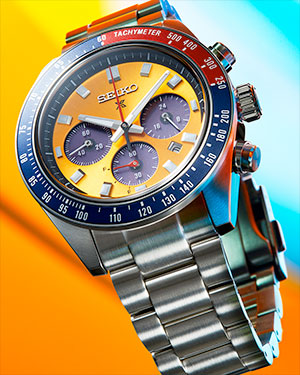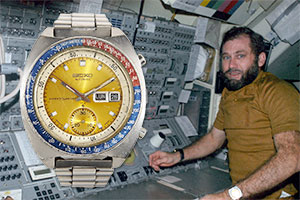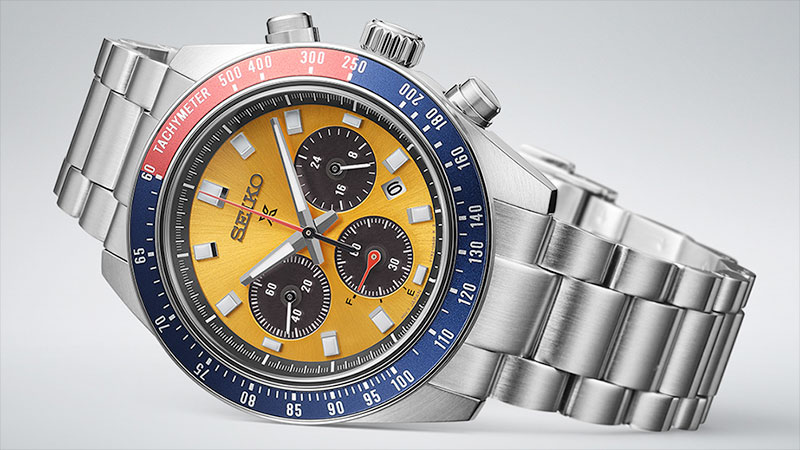 advertisements advertisements
|

|
Seiko pays colorful tribute to Skylab-flown 'Pogue' with new watch
July 15, 2024 — A new wristwatch pays tribute to the first automatic chronograph that was worn in space.
Seiko has revealed its new Prospex Speedtimer SSC947 with a colorway based on the golden yellow, red and blue watch that NASA astronaut Bill Pogue launched to the Skylab orbital workshop in 1973. Unlike the Seiko 6139, which was later nicknamed the "Pogue" after the astronaut, the new watch has a solar-powered movement with a six-month power reserve.
"Although this was not an officially sanctioned watch and it was not authorized, I put it in the pocket of my space suit during launch prep and put it on shortly after inserting into orbit," wrote Pogue in a 1993 letter documenting the history of his Seiko 6139-600x chronograph. The letter was included with the watch when it was auctioned in 2008 for $5,975, benefiting the Astronaut Scholarship Foundation.
Like all of the Apollo-era astronauts, NASA issued Pogue an Omega Speedmaster Professional to use while in space — in his case, on board the United States' first space station. Pogue set the Omega to Greenwich Mean Time (GMT) and wore it on his right wrist and used his Seiko to keep Central time on his left.
"I had trained with this watch in timing SPS [Apollo Service Module Propulsion System] burns," he wrote, referring to his Skylab 3 (or SL-4) spacecraft's main engine. "The bezel made it especially easy to time the burns."
Watch collectors and space enthusiasts did not know about Pogue's Seiko until it was spotted in some training and on board photos after his mission was over. Its newly-gained association with spaceflight raised its profile and gained it new fans.
Pogue continued wearing the watch for 19 years after he returned to Earth. He then added it to his other mementos, about 20 years prior to his death in 2014.
The 1973 Seiko Speedtimer had a 30-minute subdial, a chronograph seconds hand and a day-date display. The new SSC947 model retains the golden-yellow face and "Pepsi" red and blue bezel with tachymeter scale, but has three registers, including a 60-minute chronograph, a 24-hour hand and a power reserve indicator, in addition to a date display.
The Prospex Speedtimer SSC947 is also slightly larger than the "Pogue," with a 41.4 mm stainless steel case. It will retail for $700 when released in August.
Pogue's Skylab 3 (SL-4) mission was the third and last crewed flight to the orbital workshop. Later, during the space shuttle program, NASA authorized Seiko Alarm A829 chronographs to be worn by its astronauts. The watchmaker also designed and flew the Seiko Spring Drive Spacewalk, a timepiece specifically designed for use in the vacuum of space. |
|

The Seiko Prospex Speedtimer SSC947 features a livery inspired by the first automatic chronograph to be worn in space. (Seiko)

Skylab 4 astronaut Bill Pogue seen wearing his Seiko Speedtimer on the orbital workshop in 1973 and the same watch (inset) in 2006 when it was auctioned for nearly $6,000. (NASA/Heritage Auctions) |

Seiko's new Prospex Speedtimer SSC947 is not a replica of the 6139 chronograph that NASA astronaut Bill Pogue first wore in space, but it retains the golden yellow, red and blue colorway of the original as a tribute to the 1973 model.(Seiko) |
|

© collectSPACE. All rights reserved.
|
|

|

|
